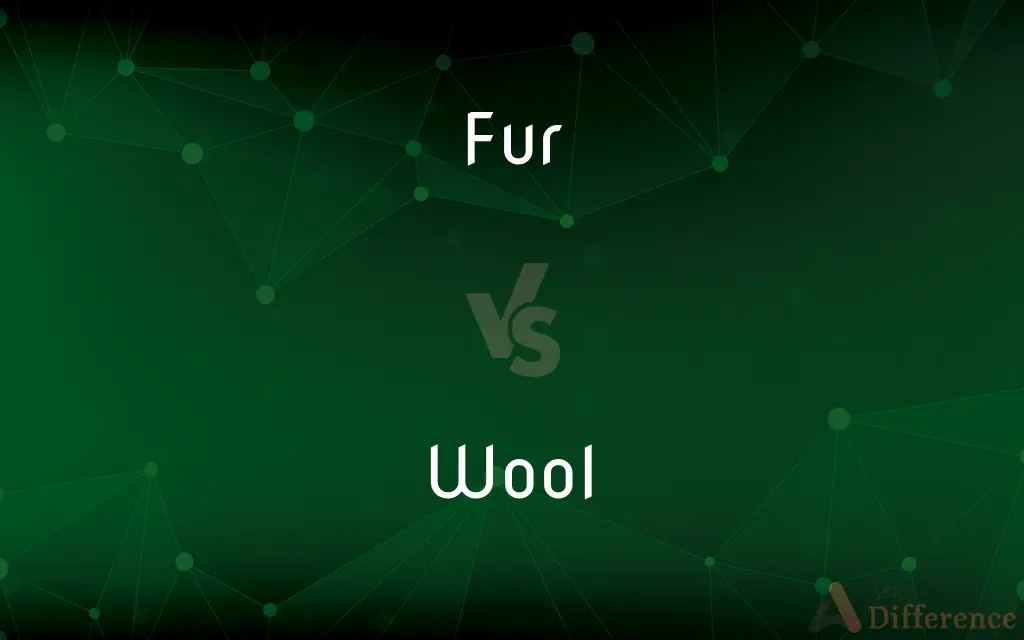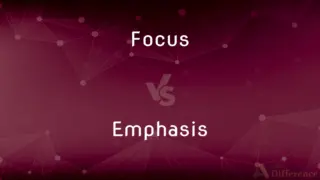Fur vs. Wool — What's the Difference?
By Tayyaba Rehman — Updated on November 4, 2023
Fur is a thick growth of hair covering the skin of many animals; wool is a soft, curly hair forming the coat of sheep.

Difference Between Fur and Wool
Table of Contents
ADVERTISEMENT
Key Differences
Fur is the thick coat of hair that covers the skin of many mammals, primarily used for warmth and protection. The hair of fur-bearing animals is typically longer and denser, with a soft undercoat that provides insulation. This undercoat is what is often used in the creation of fur products.
Wool, on the other hand, is the textile fiber obtained from sheep and certain other animals, including goats (cashmere and mohair), rabbits (angora), and camels. Wool fibers are crimped, elastic, and can be spun into a fine yarn that retains heat, making it a prime material for clothing.
The procurement of fur and wool represents different processes. Fur is obtained from the pelts of animals, which involves skinning and can often lead to ethical concerns about animal welfare. Wool is harvested through shearing the fleece of animals, a process that does not typically harm them, and can be repeated annually.
In terms of usage, fur has been historically used for high-end and luxury clothing due to its rich texture and significant warmth. It is also used for decorative purposes. Wool is widely used in everyday textiles, from sweaters and blankets to suits and socks, due to its versatility and ease of production.
Both fur and wool serve as natural insulators. However, fur is often preferred for extreme cold because of its thick, wind-resistant properties. Wool is praised for its breathability and moisture-wicking ability, making it suitable for a range of climates and weather conditions.
ADVERTISEMENT
Comparison Chart
Source Animals
Mammals like foxes, minks, rabbits
Primarily sheep, also goats, rabbits, and camels
Fiber Texture
Coarser guard hairs with a softer undercoat
Crimped, softer, and with natural elasticity
Harvesting Process
Skinning of animals
Shearing the fleece without harming the animal
Primary Use
Luxury clothing and warmth
Everyday clothing, blankets, and various textiles
Ethical Considerations
Often associated with animal cruelty
Generally considered more ethical and sustainable
Compare with Definitions
Fur
Level (floor or wall timbers) by inserting strips of wood
The drain could be concealed by furring out the original wall
Wool
Wool is a yarn or textile fiber spun from the fleece of sheep.
The wool scarf was warm and comfortable in the chilly weather.
Fur
The term fur refers to animal pelts processed for use in clothing and accessories.
Her fur coat was made from the pelts of minks.
Wool
The dense, soft, often curly hair forming the coat of sheep and certain other mammals, such as the goat and alpaca, consisting of cylindrical strands of keratin covered by minute overlapping scales and much valued as a textile fiber.
Fur
In textiles, fur is often a reference to a synthetic fabric made to resemble animal fur.
The vegan activist wore a coat of faux fur.
Wool
Filamentous or fibrous material similar to the wool of a sheep or other mammal.
Fur
Fur is a thick growth of hair that covers the skin of many different animals, particularly mammals. It consists of a combination of oily guard hair on top and thick underfur beneath.
Wool
As a fabric, wool refers to any clothing made from the woolen fibers.
His wool suit was appropriate for the formal event.
Fur
A member of a Muslim people of the mountainous and desert regions of south-western Sudan.
Wool
Wool indicates a dense, soft, often curly hair growth on animals.
The lamb's wool was sheared for the first time this spring.
Fur
The language of the Fur, an isolated member of the Nilo-Saharan family, with about 500,000 speakers.
Wool
Wool is the textile fibre obtained from sheep and other animals, including cashmere and mohair from goats, qiviut from muskoxen, hide and fur clothing from bison, angora from rabbits, and other types of wool from camelids.Wool consists of protein together with a small percentage of lipids. In this regard it is chemically quite distinct from the more dominant textile, cotton, which is mainly cellulose.
Fur
Coat or clog with a deposit
The stuff that furs up coronary arteries
Wool
The fine, soft curly or wavy hair forming the coat of a sheep, goat, or similar animal, especially when shorn and prepared for use in making cloth or yarn
Harris tweed is made from pure new wool
Fur
Covered with or made from a particular type of fur
The black-furred rabbit
Wool
Fabric or yarn made of this hair.
Fur
Relating to the Fur or their language.
Wool
Hairy or downy material on a plant or animal, as on certain caterpillars.
Fur
The thick coat of soft hair covering the skin of certain mammals.
Wool
The hair of the sheep, llama and some other ruminants.
Fur
The hair-covered, dressed pelt of such a mammal, used in making garments and as trimming or decoration.
Wool
A cloth or yarn made from the wool of sheep.
Fur
A garment made of or lined with the dressed pelt of a mammal.
Wool
Anything with a texture like that of wool.
Fur
See fake fur.
Wool
A fine fiber obtained from the leaves of certain trees, such as firs and pines.
Fur
A furlike coating
Fur on the tongue.
Wool
(obsolete) Short, thick hair, especially when crisped or curled.
Fur
To cover, line, or trim with fur.
Wool
Yarn, including that made from synthetic fibers.
Fur
To cover or coat as if with fur.
Wool
A resident of a satellite town outside Liverpool, such as St Helens or Warrington. See also Yonner.
Fur
To line (a wall or floor) with furring.
Wool
The soft and curled, or crisped, species of hair which grows on sheep and some other animals, and which in fineness sometimes approaches to fur; - chiefly applied to the fleecy coat of the sheep, which constitutes a most essential material of clothing in all cold and temperate climates.
Fur
The hairy coat of various mammal species, especially when fine, soft and thick.
Wool
Short, thick hair, especially when crisped or curled.
Wool of bat and tongue of dog.
Fur
The hairy skin of an animal processed into clothing for humans.
Wool
A sort of pubescence, or a clothing of dense, curling hairs on the surface of certain plants.
Fur
A pelt used to make, trim or line clothing apparel.
Wool
A fabric made from the hair of sheep
Fur
A coating, lining resembling fur in function and/or appearance.
Wool
Fiber sheared from animals (such as sheep) and twisted into yarn for weaving
Fur
A thick pile of fabric.
Wool
Outer coat of especially sheep and yaks
Fur
The soft, downy covering on the skin of a peach.
Wool
Wool is the soft, curly hair that forms the fleece of sheep and certain other animals.
She knit a sweater from the wool she spun herself.
Fur
The deposit formed on the interior of boilers and other vessels by hard water.
Wool
Wool can also mean the fiber used for knitting and weaving.
She bought three skeins of wool for her next knitting project.
Fur
The layer of epithelial debris on a tongue.
Fur
(heraldry) One of several patterns or diapers used as tinctures.
Fur
Rabbits and hares, as opposed to partridges and pheasants (called feathers).
Fur
A furry; a member of the furry subculture.
Fur
Pubic hair.
Fur
Sexual attractiveness.
Fur
(transitive) To cover with fur or a fur-like coating.
Fur
(intransitive) To become covered with fur or a fur-like coating.
Fur
To level a surface by applying furring to it.
Fur
Pronunciation spelling of for
Fur
The short, fine, soft hair of certain animals, growing thick on the skin, and distinguished from the hair, which is longer and coarser.
Fur
The skins of certain wild animals with the fur; peltry; as, a cargo of furs.
Fur
Strips of dressed skins with fur, used on garments for warmth or for ornament.
Fur
Articles of clothing made of fur; as, a set of furs for a lady (a collar, tippet, or cape, muff, etc.).
Wrapped up in my furs.
Fur
Any coating considered as resembling fur
Fur
One of several patterns or diapers used as tinctures. There are nine in all, or, according to some writers, only six.
Fur
Of or pertaining to furs; bearing or made of fur; as, a fur cap; the fur trade.
Fur
To line, face, or cover with fur; as, furred robes.
Fur
To cover with morbid matter, as the tongue.
Fur
To nail small strips of board or larger scantling upon, in order to make a level surface for lathing or boarding, or to provide for a space or interval back of the plastered or boarded surface, as inside an outer wall, by way of protection against damp.
Fur
The dressed hairy coat of a mammal
Fur
Dense coat of fine silky hairs on mammals (e.g., cat or seal or weasel)
Fur
A garment made of fur
Fur
Fur is the thick hair that covers the bodies of some animals.
The bear's fur keeps it warm in the frigid Arctic climate.
Fur
Fur is any soft, thick, hairy covering of the skin of an animal.
The cat's fur was soft and well-groomed.
Fur
Fur can also describe the dense, fine coat of hair that covers the skin of a person.
He shaved the fur from his face every morning.
Common Curiosities
Do fur and wool provide the same level of warmth?
Fur generally provides more warmth than wool, which is why it's used for colder climates.
Is it possible to have hypoallergenic fur or wool?
Wool can sometimes be treated to be hypoallergenic, but fur is less likely to be hypoallergenic.
Are fur and wool vegan-friendly materials?
No, fur and wool are animal-derived products, not considered vegan-friendly.
Are there synthetic alternatives to fur and wool?
Yes, there are synthetic alternatives like faux fur and acrylic yarn.
Can fur and wool be dyed and colored?
Yes, both materials can be dyed in a variety of colors.
Can fur and wool be considered luxury materials?
Fur is often seen as a luxury material, while wool varies from everyday to luxury qualities.
Can wool be harvested without harming the animal?
Yes, wool is typically harvested by shearing, which does not harm the animal.
Is wool more breathable than fur?
Yes, wool is more breathable than fur, making it suitable for a range of temperatures.
Are fur and wool biodegradable?
Yes, both are natural fibers and biodegradable under proper conditions.
Are fur and wool sustainable materials?
Wool is generally considered sustainable, but fur raises concerns due to wildlife impact.
Do fur and wool industries impact the environment?
Yes, both have environmental impacts, but fur is often more controversial due to animal welfare issues.
How do you care for fur and wool garments?
Fur requires professional cleaning, while wool garments often need gentle, cold-water washing.
Is shearing wool painful for the animals?
When done correctly, shearing is not painful for the animals.
Can both fur and wool be allergic for some people?
Yes, some individuals may be allergic to natural fibers like fur and wool.
Are fur and wool water-resistant?
Wool is naturally water-resistant to some extent, while fur can repel water but can get heavy when wet.
Share Your Discovery

Previous Comparison
Stock vs. Stalk
Next Comparison
Focus vs. EmphasisAuthor Spotlight
Written by
Tayyaba RehmanTayyaba Rehman is a distinguished writer, currently serving as a primary contributor to askdifference.com. As a researcher in semantics and etymology, Tayyaba's passion for the complexity of languages and their distinctions has found a perfect home on the platform. Tayyaba delves into the intricacies of language, distinguishing between commonly confused words and phrases, thereby providing clarity for readers worldwide.
















































